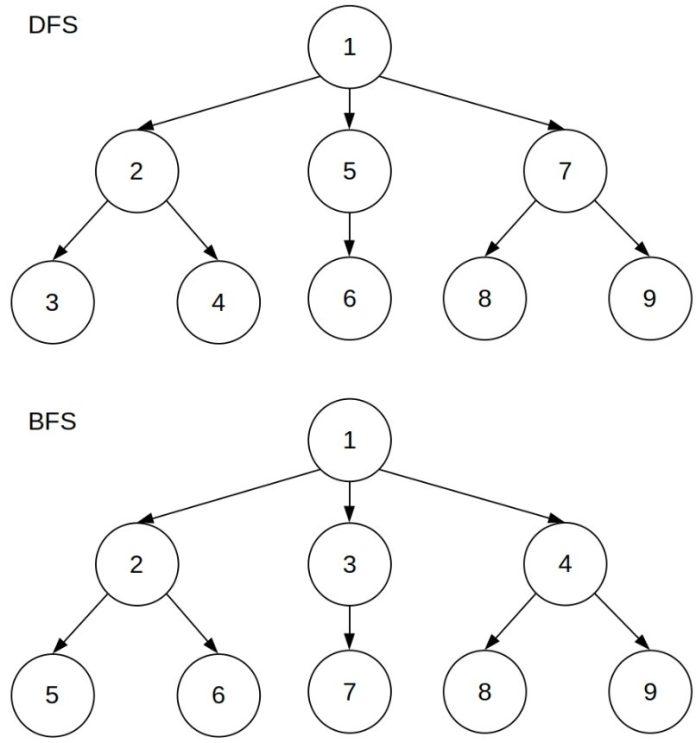BFS: Fundamental Concepts
Breadth-First Search (BFS) operates by systematically exploring all the vertices on the current level before moving on to the next level. This ensures that the traversal spreads breadth-wise through the graph.
DFS: Digging into Depth-First Search
In contrast, Depth-First Search (DFS) delves as deep as possible along one branch before backtracking. It plunges into the depths of the graph, exploring as far as possible before moving on.
Key Differences Between BFS and DFS
Understanding the Difference Between BFS and DFS is pivotal for choosing the right approach. While BFS prioritizes exploring neighboring nodes first, DFS takes a more profound, iterative approach, often yielding different outcomes.
Applications of BFS
BFS finds its applications in various domains, from network routing to shortest path finding. Its ability to systematically explore adjacent nodes makes it invaluable in scenarios where the proximity of nodes matters.
Applications of DFS
Depth-First Search, with its deep exploration approach, excels in tasks like topological sorting and maze solving. Its adaptability makes it suitable for scenarios requiring in-depth analysis.
Pros and Cons of BFS
BFS’s strengths lie in its guarantee of finding the shortest path, but it comes at the cost of increased memory requirements. Understanding these trade-offs is essential for optimal utilization.
Pros and Cons of DFS
Depth-First Search, with its memory efficiency, proves advantageous in certain situations. However, it may lead to non-optimal solutions and lacks the guarantee of finding the shortest path.
Optimizing BFS for Efficiency
To enhance BFS performance, optimizing data structures and leveraging parallel processing can be instrumental. These strategies ensure efficient exploration of the graph’s breadth.
Enhancing DFS for Specific Use Cases
Tailoring Depth-First Search involves strategies like pruning unnecessary branches and utilizing heuristics. These optimizations align DFS with specific use cases, maximizing its effectiveness.
BFS vs. DFS: Decision-Making Criteria
Choosing between BFS and DFS depends on factors like the nature of the problem, memory constraints, and the desired outcome. This section provides a comprehensive guide for informed decision-making.
Real-world Examples of BFS
In network data transmission, BFS ensures the efficient routing of packets. Its ability to prioritize adjacent nodes mirrors real-world scenarios where proximity matters.
Real-world Examples of DFS
In maze-solving algorithms, DFS proves efficient by exploring possible paths deeply. This mirrors situations where a comprehensive exploration is necessary before deciding the next move.
Challenges in Implementing BFS
While BFS guarantees optimality, it faces challenges in scenarios with limited memory. Balancing the need for optimal solutions with resource constraints is a common struggle.
Challenges in Implementing DFS
Depth-First Search may lead to non-optimal solutions, especially in tasks requiring the shortest path. Navigating these challenges involves careful consideration of problem constraints.
VISIT ALSO: What is Red-Black Tree: Your Guide to a Balanced Data Structure
FAQs About the Difference Between BFS and DFS:
Q: How does BFS prioritize nodes during traversal?
BFS systematically explores neighboring nodes before moving on to the next level, ensuring a breadth-first approach.
Q: Can DFS guarantee finding the shortest path?
DFS lacks a guarantee of finding the shortest path due to its deep exploration approach, which may lead to non-optimal solutions.
Q: Are there scenarios where BFS is more suitable than DFS?
Yes, BFS excels in scenarios where the proximity of nodes matters, making it preferable for tasks like network routing.
Q: What optimizations can be applied to enhance DFS performance?
Pruning unnecessary branches and utilizing heuristics are effective strategies for optimizing Depth-First Search in specific use cases.
Q: How do BFS and DFS differ in memory requirements?
BFS typically requires more memory due to the systematic exploration of neighboring nodes, while DFS tends to be more memory-efficient.
Q: In what real-world scenario is DFS commonly applied?
DFS is frequently used in maze-solving algorithms, where deep exploration of paths is essential before making decisions.
VISIT ALSO: Lippan Art Kit: Your Creative Gateway
Conclusion
Navigating the intricate world of graph traversal, understanding the Difference Between BFS and DFS is paramount. Armed with insights into their applications, strengths, and challenges, you’re equipped to make informed decisions in diverse scenarios. Embrace the power of these algorithms and unlock new possibilities in your journey through graph theory.
